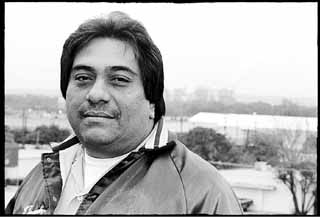Holly on Hold
Passage of the Holly Neighborhood Plan gets postponed for lack of neighborhood participation.
By Lauri Apple, Fri., Oct. 19, 2001

How many people does it take to develop an acceptable neighborhood plan? Definitely more than 2% of neighborhood residents, say Planning Commission members, who on Sept. 26 decided to postpone voting on the Holly Neighborhood Plan until city staff received additional resident input. Commissioner Sterling Lands, who voted to postpone, says, "involvement [in neighborhood planning] has been light across the board, but not this light."
The Holly plan affects an area bounded by East Seventh, Pleasant Valley, Town Lake, and Chicon. In addition to low participation, the Holly plan has been hindered by a cultural fault line dividing vocal property owners (including nonresidents) and supporters of the city's Smart Growth initiative from those equally vocal neighborhood activists who use "Smart Growth" interchangeably with "gentrification." To Holly Neighborhood Planning Team chair Gavino Fernández (who also belongs to the El Concilio coalition of Mexican-American neighborhood associations), the city's neighborhood planning process is inherently "biased": That is, it inevitably supports development that increases housing prices and drives out low-income residents. He also considers the process "misleading" because it incorporates measures for light rail, which he and other El Concilio leaders oppose. "It's not a genesis plan coming from the neighborhood," Fernández said, "so within the neighborhood, you'll find a lot of apathy and not a lot of participation."
Fernández also believes the city confused people by naming the plan after the Holly Street Power Plant -- a name used only by the media and the city, he says. In the late Nineties, he and other Hispanic East Austin neighborhood activists submitted a plan as the El Pueblo Network, which also included representatives of social service and advocacy groups with ties to the affected neighborhoods. El Pueblo's plan encompassed an area too large for the city's taste, so the Planning Commission broke it up into smaller components -- including the neighboring East Cesar Chavez area. Fernández describes the process as "breaking neighborhoods by imposing the [city's] plan."
At the Sept. 26 Planning Commission meeting, Fernández advocated for affordable housing -- particularly on East Fifth and Sixth streets -- and spoke against zoning that changes currently light-industrial areas (LI) to commercial services (CS) and light industrial-mixed use (LIMU). His move agitated some members of the Holly planning team -- including Bill Stringer, a nonresident property owner who believed that after 18 months of working together, the group had reached a consensus. "I don't have a problem with [Fernández], but the conflict is really caused by what he's doing," Stringer says. "Now that there is a consensus and the neighborhood has voted, he's taken up his own banner."
A commercial real estate agent for almost 30 years, Stringer has owned a 20,000 square-foot warehouse at 2000 E. Sixth (currently occupied by Fourthstage, an Internet technologies provider) since 1978. He supports having a Hispanic resident chair the Holly Neighborhood Planning Team in order to promote residents' objectives but questions whether Fernández actually speaks for the neighborhood or just for himself. He agrees that affordable housing is needed, but thinks it's unreasonable to build it among Holly's warehouses, recycling plants, and railroad tracks. The city should develop housing further east ("by Highway 183, for instance") where land is cheaper, he says, assuming voters approve light rail for that area.
"Gavino would like to see houses built where my warehouse is," says Stringer, whose major concern with the plan is that whatever zoning changes are adopted don't restrict him from using his building as it has been used in the past. "If [the city] can get $10,000 in taxes out of me for a warehouse, they won't need as much out of him. I don't know if he sees the whole picture."
Opportunities for affordable housing exist in the Holly area, says Neighborhood Planning and Zoning Dept. planner Mario Flores, the city staffer assigned to assist with the Holly plan. But housing that receives federal funding must comply with HUD standards, which preclude building too close to the Holly area's railroad tracks due to noise and safety issues. The plan would approve building garage apartments and grant amnesties to owners of illegal lots (smaller than 5,750 square feet) to increase residential space.
Despite the "highly political situation," Flores believes Holly planning team members drafted a workable plan that gradually scales back on light-industrial to ensure that adjacent land uses remain compatible. While the city's outreach process -- including workshops, radio ads, mailings, church bulletin notices, open houses, 18 months of bimonthly meetings, and neighborhood surveys -- didn't produce stellar turnout rates, residents were successfully informed, he says.
"If changes need to happen, why aren't residents more involved?" asks Stringer, who nevertheless understands the Planning Commission's concerns about low neighborhood participation. Fernández believes Holly-area residents didn't show up to Planning Team meetings for many reasons: lack of faith in government, unfamiliarity with zoning lingo and planning rhetoric, illiteracy, little access to computers, or some combination. He agrees that city staff who assisted with the Holly plan made a conscientious effort to involve the community, but says business owners outnumbered residents during the planning process. ("That's definitely false," says Flores, who estimates that meetings usually attracted four resident advocates for every business owner.)
The deadline for presenting the Holly plan and rezonings to the Planning Commission is Nov. 28; City Council has postponed considering the plan until Dec. 6, pending the Commission's recommendations. On Nov. 5, commissioners and city staff will hold a "community session" at Metz Elementary to get more neighborhood input on the zoning recommendations. But Fernández doubts it will help much. "I don't know what miracles the Planning Commissioners are going to come up with," he said.
Got something to say on the subject? Send a letter to the editor.








